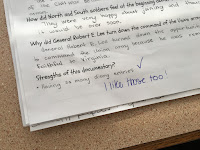
Essential Question: Why does authorship matter in primary and secondary sources?It is important to teach people to question what is believed about events in history and in the news today. Why do we believe what we believe? Because historians interpreted the evidence certain ways. So, why not, with events that get one or two lines in history textbooks, allow students to do a little interpreting of their own. Nat Turner and John Brown allow students to see that much of the American story can be learned, not just from those who were on the winning side, but those who were considered criminals, dissidents, and troublemakers. I want kids to question textbooks, websites, and source authorities. History is alive, debatable, and connected to the present in lingering ways. This activity was adapted from a lesson idea from the incredible book "Why Won't You Just Tell Us the Answer" By Bruce A. Lesh. He is an incredible author who redefines teaching history and focuses on students asking questions, analyzing evidence, and developing historical explanations of their own.
 To begin, students were confronted with a series of images of Nat Turner and John Brown. These images range from contemporary to primary sources. As each image was displayed and passed around the groups, students were asked to describe how the character and their actions are being depicted by the author. After looking at 5 or 6 images, students start piecing together that this may be one event, one specific guy maybe? I confirmed that each one is showing antebellum slave revolts and that the two characters depicted are Nat Turner (1831) and John Brown (1851), both leaders of fatal slave rebellions.
To begin, students were confronted with a series of images of Nat Turner and John Brown. These images range from contemporary to primary sources. As each image was displayed and passed around the groups, students were asked to describe how the character and their actions are being depicted by the author. After looking at 5 or 6 images, students start piecing together that this may be one event, one specific guy maybe? I confirmed that each one is showing antebellum slave revolts and that the two characters depicted are Nat Turner (1831) and John Brown (1851), both leaders of fatal slave rebellions.WHY WOULD WE GET SUCH DIFFERENT VIEWS OF THEM?
The final assessment was to create a historical marker for either John Brown's Harper's Ferry Raid or Nat Turner's rebellion. They needed to share THEIR interpretation of either Nat Turner or John Brown and their actions.















































